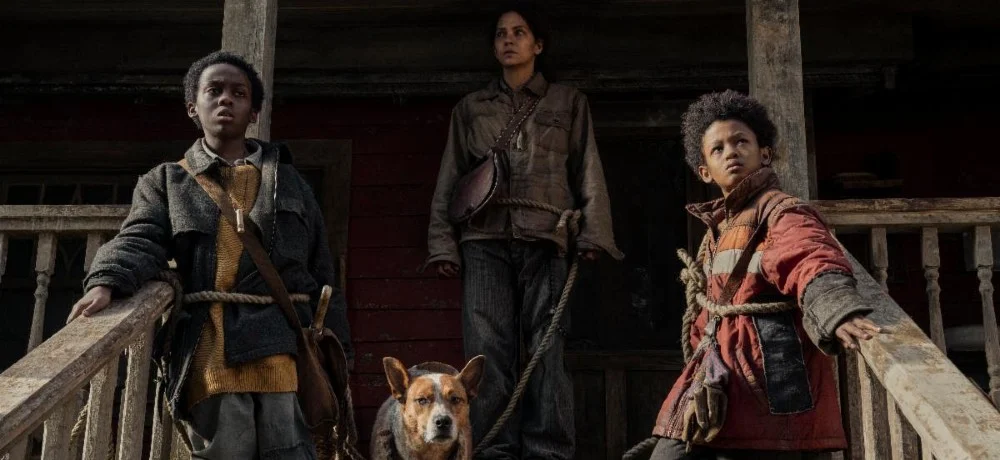


Never Let Go blends dystopian storytelling with folkloric haunts and a traumatized Halle Berry to hatch something emotionally resonant yet out of reach. Director Alexandre Aja brings his brutal visual signatures to what could otherwise be a children's horror fairytale. Writers Kevin Coughlin and Ryan Grassby bind a family to their homestead in the most literal representation of "never letting go," exploring how living with our demons versus confronting them head-on can lead to dire repercussions. Themes are easily identifiable, and Aja's grotesque touches elevate the stakes, but satisfaction is missing from finale climaxes. The existential questions Coughlin and Grassby's story asks are engaging and tough, but the film's blatant responses hit you over the head one too many times.
Halle Berry stars as a tattooed mother who protects her children Nolan (Percy Daggs IV) and Samuel (Anthony B. Jenkins). They retreat into nature's isolation, a blessed house with protective wood that wards off "The Evil." Nolan, Samuel, and their "Mama" can only leave home if wrapped in a thick rope tethered to foundation roots — as long as they're touching the rope, The Evil cannot harm them. But, as food rations vanish and bellies rumble, Nolan questions whether his family's predicament is real or imaginary. Is The Evil a manifestation of Mama's extreme desire to avoid her past? Or does a presence lurk in them there woods that wants to tear the trio apart.
Aja's background in gory American horror remakes and New French Extremity is downplayed in Never Let Go. The filmmaker appeals to an adolescent whimsy that sees the world through inexperienced eyes. Nolan and Samuel are boys who do right by their mother but don't know anything outside her teachings. You’re meant to question Mama's truths and intentions with every uttered warning because Never Let Go can be a thrilling familial fight against demons or legitimate imprisonment. Aja keeps that question looming over most scenes, which sustains a speculative tension throughout Mama's frantic adherence to prayers and engravings meant to prevent horrors — as long as those horrors exist.
That throughline, the question of "is this kidnapping or is the Devil real," leads to mounting standoffs as characters lose faith. Berry works well with her young supporting co-stars as a mother who, through her passionate survivalist fears (or mental suffering), sells the hell out of The Evil's wretchedness. Then there's the brothers’ inquisitive side — Jenkins and Daggs do the whole "kids being kids" routine with proper trepidation, turning tides against Berry's dictatorial parent. Never Let Go only expands as far as the ropes stretch, which means Aja relies on his trio of actors to drape suspense like a weighted blanket. Through their dinner munching of tree flesh covered in sap, hermit anxieties, and Mama's unbelievable claims, the cast is primarily successful — until Act III.
When Never Let Go pivots, it becomes too literal an experience despite insistances that two outcomes are viable. All those ominous feelings are hammered into place with striking force. There's an exploration of "holding onto fear helps nothing, embracing the unknown can heal," but it's out of alignment with what makes the preceding buildup succeed. A moment where Jenkins and Daggs confront a hiker stands out as the boys must decipher if he's real or if it's another trick by The Evil, but a scene like that still deals with non-answers. The film becomes less fulfilling once the story takes a stance, and the illusion of unreality fades away (whether Mama's right or wrong). There's power in desires to leave answers open-ended — impact fades when all becomes clear.
Aja's deliverance of The Evil's many representations honors his horror-forward catalog. What Mama sees — that only she can see — are ghoulish manifestations of figures from her past. Mama's bloated corpse of a mother, her shrieking father, the rotten corpse of a girl, her ex-husband. They're all decayed; wounds are showing, and their tongues split like a serpent. Sometimes Mama sees Nolan or Samuel with flesh pecked into raw meat by ravens, but most times, The Evil alludes to zombified reptilian attributes. Aja uses these accents sporadically to remind what prowls outside, what Mama is terrified to encounter, culminating in a final form that I wish saw more usage. Alexandre Aja: The Horror Filmmaker is still on display.
Never Let Go is a slippery American fable that doesn't quite stick the landing, but puts together an impressive enough routine beforehand. Aja's employment of snake-like imagery teases a biblical force that wants to destroy, while questions of reliability abound as Mama's behaviors are challenged. It's a film that gets lost in its intentions but, when at its most elusive, shackles us to the mysteries of its existence. Some will find catharsis in the film's closing scenes, while others will swallow frustration. Sometimes, what goes unsaid is the most potent statement — Never Let Go gives the audience a little too much to chew on.
Movie Score: 3/5